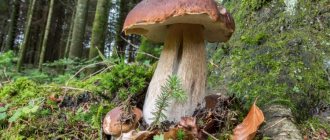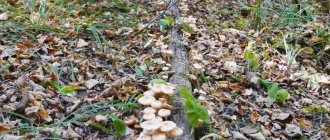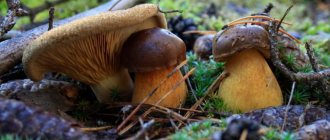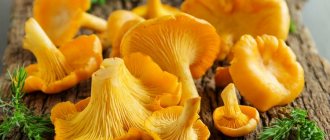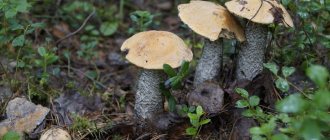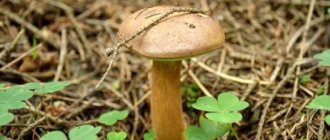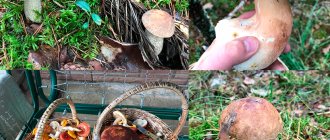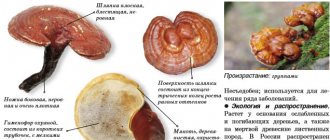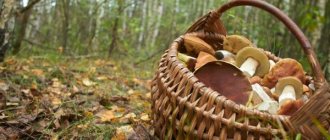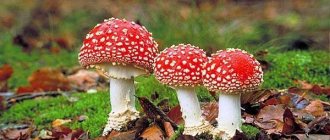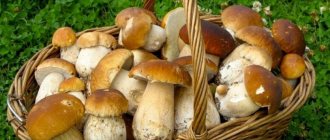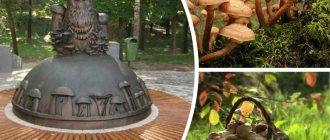A mosaica.ru correspondent tells which forests in the region are rich in autumn gifts.
The “silent hunting” season is in full swing; mushroom pickers have gone out into the forest with knives and baskets. Ulyanovsk residents share their “catch” on social networks, posting photos there and admiring the forests of the Ulyanovsk region rich in mushroom harvest. But where exactly can you find a treasure trove of mushrooms? A mosaica.ru correspondent asked this question to avid mushroom picker Evgeniy Sofronov.
– You know, a real mushroom picker will never show his mushroom places. One day two years ago I brought a friend to my favorite place. We collected a lot of mushrooms, and I asked him not to talk about this place, but they didn’t listen to me, and after a while they brought friends there... In general, now you don’t have to go to those places, there are always a lot of mushroom pickers there,” Evgeniy noted.
But Evgeny Valentinovich still shared in which direction he should move if he was going to pick mushrooms.
Mushroom places of the Ulyanovsk region
The forests of the Ulyanovsk region are completely covered with mushrooms, many of which, according to local mushroom pickers, most often like to settle near forests, parks, and plantings. A more accurate map of mushroom places in the Ulyanovsk region looks like this:
- Victory Park. Here you can find edible fruits such as honey mushrooms and honey mushrooms. They grow in the northern part of the park. And if you go towards the cardiological clinic, then along the way you can pick up porcini mushrooms.
- Military unit. Not far from it there is a forest clearing where milk mushrooms, white mushrooms, and honey mushrooms - Assumption and summer mushrooms - settle en masse.
- The village of Polivno. Here you can find completely different edible and conditionally edible mushrooms.
- Ulampek base. On the territory there is a pine forest where saffron milk caps, volnushki, strings, morels, boletus and forest champignons grow.
- The villages of Arskoe and Krotovka. In these areas there are many coniferous plantations where you can find fragrant saffron milk caps, chanterelles, and hygrophora. And these fruits, as you know, are excellent for making soups and broths. They are also used to prepare various types of delicious winter preserves.
- The village of Dvoriki. Behind this village there is a forest in which champignons and autumn honey mushrooms grow.
Photos of the harvest collected in past years:
Mushroom places will help to collect mushrooms in the Ulyanovsk region in 2022. Visual clues will allow even a beginner who decides to go on a quiet hunt to collect a variety of protein products containing vitamins, minerals, macro- and microelements in their pulp.
Mushroom picking dates in 2022
Traditionally, the mushroom season in the Ulyanovsk region begins at the end of July and lasts until October. This happens year after year, and no significant changes are expected in 2022. This period is the most optimal for collecting many well-known and popular fruiting bodies.
But there are also earlier mushrooms, for example, morels and strings begin to appear in early spring - back in March. They are not particularly popular, however, they are quite suitable for the first mushroom harvest of the year.
Mushroom calendar
It should be noted that mushrooms are seasonal. Some occur in early spring, while others occur in late autumn. There are species that delight us only for one or two weeks, and then disappear until the following years, while others begin to grow in early spring and last until the first frost.
| PERIOD. | What they collect. |
| Beginning of May | Morels, stitches, birch sponges. |
| The end of May. | White, oyster mushroom. |
| The beginning of June. | Honey mushrooms, boletus, boletus, russula, fly mushrooms. |
| Mid June. | White, oak, boletus, boletus, russula, boletus, less often chanterelles. |
| End of June – beginning of July. | Volnushki, milk mushrooms, garlic mushrooms, nigella, white milk mushrooms. |
| July. | Volnushki, milk mushrooms, garlic mushrooms, nigella, white milk mushrooms. |
| August. | White mushrooms, chanterelles, green moss mushrooms, milk mushrooms, russula, yellow oak mushrooms, russula, cape mushrooms, boletus mushrooms. |
| September. | White mushrooms, moss mushrooms, milk mushrooms, saffron milk caps, aspen mushrooms, boletus mushrooms, russula, chanterelles. |
| First frost. | White boletuses, boletuses, chanterelles, moss mushrooms, boletus, russula, saffron milk caps. |
Growth depends on many factors; climatic conditions, of course, play an important role. Precipitation, humidity, temperature, forest type - all this affects the mushroom season. We must remember that mushrooms are a whole kingdom, unique, with their own characteristics. The main thing that every mushroom picker should know is that safety comes first.
Description of edible species of the region
Mushrooms in the Ulyanovsk region must be looked for not so much by name as by the time of fruiting. According to this criterion, they are conventionally divided into spring, summer and autumn.
First spring mushrooms
The most interesting fruits that begin to appear from under the snow are strings and morels. In the spring, Ulyanovsk mushroom pickers usually collect:
- Morels are edible. These fruits belong to the category of conditionally edible, but after preliminary boiling they become completely suitable for consumption. They can be recognized by their irregular, brain-shaped cap, which is colored ocher-yellow, gray or brown. Morels grow from April to May in fertile soil enriched with lime.
- Birch polypore. The mushroom is also called birch sponge. A distinctive feature is the complete absence of a leg. The tinder fungus is attached to the tree bark with its fruiting body. It grows, as the name suggests, on birch trees, but prefers mostly dead trees. I collect mushrooms from early summer until late autumn, using them to prepare medicinal tinctures and decoctions.
- Champignon. Some types of champignons can be found in the spring forests of Ulyanovsk. They prefer parks, ravines, clearings, forests, and shelterbelts. Most often, mushrooms settle near poplars, chestnuts, and acacias. Champignons grow in colonies of several in a row.
On a note!
Champignons have false counterparts that are poisonous. Therefore, when collecting these fruits, it is necessary to know exactly what an edible specimen looks like.
Summer varieties
Summer is the most favorable time for “silent hunting” in Ulyanovsk. During this period you can find the most popular types of fruits:
- White mushrooms. These specimens can be recognized by their massive fruiting body. Their cap grows to 30-40, and sometimes 50 cm in diameter. The leg is stocky, powerful, dense. If you break the flesh, the white mushroom turns bluish from the inside. Such fruits grow mainly in coniferous forests, but can be found in mixed plantings under pine or spruce trees.
- Dummies. This group of fruits includes boletus and boletus. Specimens can be recognized by the colors of their caps. In the boletus it is orange with a pinkish tint, in the boletus it is brown. The legs of both varieties have numerous dark scales. Fungi form mycorrhizae with both coniferous and deciduous trees.
- Chanterelles. This is one of the most beloved fruits, revered by mushroom pickers throughout Russia. The cap of this specimen is painted bright orange and has a diameter of 10 to 14 cm. The flesh is juicy and elastic, but is difficult to separate from the skin. Therefore, before eating chanterelles, it is not necessary to thoroughly clean them - the main thing is to remove dirt and debris. You can find these fruits on the edges of parks, as well as in mixed forests. The first specimens appear in July, and the fruiting time ends in November.
- The oiler is grainy. A mushroom with a shiny and sticky surface, brownish-red in color, which has ideal taste. It begins to bear fruit in June, and the end of the period occurs in October. It forms mycorrhizae with Scots pine, and less commonly with other types of conifers. Prefers young plantings of trees, clearings, edges, and clearings. You can also find boletus along the roads, but you shouldn’t collect them there.
Milk mushrooms, oyster mushrooms, summer mushrooms and mushrooms - these mushrooms can also be enjoyed during the hot season. All of them grow in the Ulyanovsk region, and are very revered by local mushroom pickers.
Recommendations before your trip
- №1
To harvest a fresh and healthy harvest, it is recommended to collect mushrooms only in environmentally friendly places. Areas such as highways, nearby areas, cemeteries, landfills and factories should be avoided.
- №2
It is worth preferring old mushrooms - young ones that have not had time to absorb toxins and carcinogens. This is especially true for strings and morels, honey mushrooms, greenfinches and hygrophores.
- №3
Regardless of the time of year, you should dress in closed clothing that protects you from attacks by insects and snakes. A hat and boots are mandatory items that are used regardless of the weather.
The best clothing option, regardless of gender, would be a set consisting of the following items: a turtleneck with a high neck, jeans, a cap or hat, and rubber boots. For cold weather, you need to wear outerwear over it: a down jacket or a windbreaker.
- №4
You should not collect unknown mushrooms that raise questions. It is better to leave the forest with an empty basket than to harm your health out of ignorance.
Inedible and poisonous mushrooms
Along with edible fruits, in the Ulyanovsk region you can find mushrooms that are not worth, and sometimes even dangerous to eat. The most common of them are:
- Lines. Mushrooms are not eaten as they contain poisons and toxins that are harmful to health. These fruits can be easily confused with edible morels, which is where their danger lies.
- The pig is thin. A poisonous mushroom that grows from June to October. Settles in forests of various types, prefers damp and shady places. More often it grows in groups, less often – singly.
- Satanic sickness. A very bright mushroom that is almost impossible not to notice. It grows in deciduous forests among beech, hornbeam, oak, hazel, linden and edible chestnuts. The fruiting period begins in June and ends in September. The mushroom is poisonous and extremely toxic.
- Red fly agaric. Even an inexperienced mushroom picker can recognize this specimen. The noticeable red cap is strewn with white droplets, similar to flakes, and should immediately alert you when picking mushrooms. A young fly agaric has an ovoid cap, but over time it becomes prostrate. The leg is whitish, high. Red fly agarics often grow next to edible mushrooms, which should not be collected due to their proximity to a poisonous fruit.
- Death cap. This deadly poisonous mushroom grows in all regions of Russia. Many grebes can be found in the forests of Ulyanovsk and the region. The color of the cap and legs has a green tint. The mushroom grows in different areas - forests, parks, ravines, and on the edges. It can even be found in the garden or vegetable garden. The danger of toadstool is that it perfectly camouflages itself as a champignon and a white row.
Important!
Inedible mushrooms should not be eaten solely because of their bitter taste and unpleasant odor. But even if this happens by accident, they will not cause much harm to health. But poisonous fruits often cause severe poisoning and death.
List of recommendations and tips for beginners
Beginning mushroom pickers who decide to take up a new exciting hobby are advised to follow useful tips and tricks that can increase the chances of reaping a rich harvest. A list of five points will prevent you from leaving the forest with an empty basket, returning home in a bad mood.
- First - the best mushroom places
In order not to wander through the forest thoughtlessly and empty, you should not go on a quiet hunt, focusing on internal prejudices. It is more correct to study in advance the posts consisting of reviews and recommendations in order to make a final conclusion whether there are mushrooms in the Ulyanovsk region in 2022 today or not, and where the best mushroom places are worth going to. Answers to simple questions will simplify the collection task, reducing the harvesting time by several hours, allowing you to spend the saved day on cleaning and further heat treatment.
- Second - optimal time
The day and time for quiet hunting also affect the harvest and volume of the harvest. When going in search of edible fruits on weekends, mushroom pickers deprive themselves of priority, facing competition from fellow mushroom hobbyists. The same goes for time. Experienced mushroom growers know that after lunch, apart from cutting off the stems in the forest, it is difficult to collect mushrooms for harvesting for the winter. The most you can hope for is soup or fried potatoes with mushrooms.
- Third - weather conditions and humidity levels
In dry weather, you can’t rely on fresh mushrooms rich in vitamins, micro- and macroelements. From the strength that catches your eye, these are medicinal herbs that do not require watering for full growth. To avoid a bitter experience, before choosing a day for a quiet hunt, you should carefully study the forecast of the hydrometeorological center. It is easier to find a good harvest 5-7 days after heavy rains, when the region maintains above-zero temperatures and the sun is warm.
- Fourth - level of edibility
Mushrooms are divided into groups according to their level of edibility, so that mushroom pickers understand which mushrooms do not require heat treatment and cleaning, and which require boiling, then draining the broth and washing. In this way, toxins and carcinogens contained in the pulp of conditionally edible mushrooms in small volumes are removed.
- Fifth - distinctive features
To protect your body and the health of your loved ones from the effects of poisons and other dangerous additives contained in the pulp of poisonous, inedible and hallucinogenic mushrooms, you should memorize the distinctive features. Accurate characteristics, combined with photo and video comparison, will make it easier to remember which mushrooms are safe and healthy to collect, and which ones you should not pay attention to.
Of course, it is difficult to remember more than 500 species of mushrooms that are included in the group of prohibited for consumption and grow in the Ulyanovsk region. However, the most common and false subspecies that often catch your eye will still have to be memorized. Particular attention should be paid to poisonous analogues of such mushrooms as:
- umbrellas (butts) and the entire champignon family;
- honey mushrooms (meadow, summer, spring, autumn and winter);
- chanterelles;
- boletus;
- rows;
- Russula;
- waves;
- saffron milk caps;
- morels.
Mushroom picker tips
You may be interested in: How do edible talkers differ from false mushrooms? How many days after rain do mushrooms grow? Bitter mushroom: photo and detailed description
If you are just starting to try yourself as a mushroom picker, do not forget to take a few useful tips from experienced mushroom growers before heading into the forest:
- Do not take unfamiliar fruits. Go only for those mushrooms that you know. Do not pick suspicious, wormy, damaged specimens, especially with bare hands.
- Place the mushroom harvest in a basket. If you use a bag or bucket to collect fruiting bodies, then in such a container they will wrinkle, break and quickly deteriorate.
- Move away from roads and industrial enterprises. Mushrooms tend to absorb and accumulate harmful substances. Heavy metals, toxins and other elements are not neutralized even after prolonged cooking and subsequent heat treatment. Therefore, when picking mushrooms, you need to move at least 500 m from the road.
Remember!
And the last important piece of advice: when going on a “silent hunt” in an unfamiliar place, be sure to leave notes behind you. In case you get lost, they will help you get back to your starting point.
The year 2022 pleased lovers of aromatic and tasty mushrooms with a rich harvest. According to experts, 2022 will be no less generous, so with the onset of spring warmth, you can safely go shopping for your favorite mushrooms again.
Search life hack
Once you have decided on the direction of where to go for the prey, it is important to find this prey correctly and not miss anything. A life hack for picking mushrooms was formulated by mushroom expert A.I. Semyonov back in Soviet times. He structured the data and collected it into a single system, thanks to which it is easiest to find natural gifts.
So, before you start searching, look around and understand what kind of forest you are in. If the trees are planted by a person (the plants grow in even rows and at the same distance from each other), then you need to move according to the “comb” pattern. In this case, you need to navigate along the rows of trunks and not miss a single meter of area.
The next method is the “comb with a protrusion”. This is already a complicated version of the search; it is unlikely that anyone will check their path on purpose.
If there are few trees in the forest, then you can use the “wave” or “zigzag” patterns.
The edge of the forest adjacent to the clearing can be inspected using the “stretched spring” principle, walking around each tree.
The zigzag method will also help in wild forests.
If you find the first mushroom, then do not rush to leave the good place, mark it. Place a stick or some object there and start moving in a spiral around this place.
To improve your chances, spiral in all directions.
If you come together to pick mushrooms, it is best to combine methods. While one uses the “stretched spring” principle, the other can move along a zigzag path.
And remember the main rule of a mushroom picker: if you’re not sure, don’t take a mushroom. Happy hunting!
Photo by Evgeny Sofronov, infographics by Inna Barzyuk
Safety measures in the forest
To prevent mushroom poisoning, it is important to follow these rules:
- If you don't know, don't take it! Collect only familiar types of mushrooms.
- Collect mushrooms away from roads, highways, outside populated areas, in ecologically clean areas.
- Collect mushrooms in wicker baskets - this way they will stay fresh longer.
- Cut off each mushroom with its stem intact.
- All mushrooms brought home on the same day must be sorted, sorted by type and carefully reviewed again. Throw away all wormy, overripe, legless, flabby mushrooms, as well as inedible and poisonous ones, if you collect them by mistake.
- Don't forget that mushrooms are protein, and any protein spoils very quickly. Therefore, mushrooms must be cooked on the day of collection, having previously sorted them by type, if you are not preparing assorted mushrooms or mushroom caviar.
To avoid mushroom poisoning, remember not to:
- Collecting mushrooms in buckets, plastic bags or sacks leads to rapid spoilage and damage to the stems of the mushrooms, which will significantly complicate subsequent sorting and sorting and can lead to poisonous mushrooms getting into the dish;
- Collect old, overgrown, wormy and unknown mushrooms;
- Try mushrooms during picking;
- Cook mushrooms a day or more after picking;
- Marinate or pickle mushrooms in galvanized dishes and glazed clay dishes;
- Keeping mushrooms warm is a perishable product.
What mushrooms grow in the Tambov region.
Staromainsky district
The forests are rich in honey mushrooms
In the Staromainsky district of the Ulyanovsk region, milk mushrooms and honey fungus grow from mushrooms in deciduous and coniferous forests.
Gruzd
The cap is fleshy, its diameter is from 6 to 23 cm. There is a small depression in the middle. Young representatives have well-defined pubescence along the edges of the cap.
The skin is white or somewhat creamy, with pinkish pigmentation; when precipitation occurs, the surface becomes sticky. The pulpy part has a dense structure, a typical mild aroma, as well as a pronounced pungent taste. Another typical feature is that this mushroom secretes a whitish milky juice with a bitter taste.
The leg is up to 10 cm in length, stable and narrowed at the bottom. The plates are closely spaced and have a narrow lumen. Spore powder is characterized by a pink color.
Honey fungus
Honey mushrooms have a long, thin and flexible leg - 12-17 cm in height. The color ranges from white to brownish. There is a ring separating the cap and the stem itself. The ends of the cap are turned up and point down. Young representatives of this group of fungi have dark-colored scales on their surface, which disappear as the fungus ages.
The cap is rounded down; in a young mushroom it is dark and scaly, becoming smoother with age. Hats come in cream or white, yellow and reddish shades.
Irina Selyutina (Biologist):
Honey mushrooms are a collective “company”, which includes species belonging to different genera. What unites them is mainly the place of growth - stumps. Translated from Latin, the word Armillaria – denoting the genus of honey mushrooms – is “bracelet”. Thus, scientists demonstrated that mushrooms grow in large groups - a kind of living bracelets surrounding the perimeter of stumps. There are also known species that have chosen meadows for their residence - meadow honey mushrooms or negniuchnikovs from the Negniuchnikov family.
In general, honey mushrooms are not very large mushrooms. And if they did not grow up in large families, they would constantly be mistaken for toadstools.
Fans of “quiet hunting” have probably made a note in their memory - honey mushrooms become very abundant after the rains. Temperature doesn’t really matter here: after all, if warming occurs, some species will appear, and if there is a cooling, others will appear. It turns out that they can be collected almost all year round. The main thing is to have the required level of humidity.
You can collect these mushrooms in Ulyanovsk in the second half of summer.
